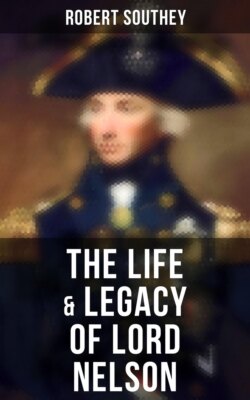The Life & Legacy of Lord Nelson

Реклама. ООО «ЛитРес», ИНН: 7719571260.
Оглавление
Southey Robert. The Life & Legacy of Lord Nelson
The Life & Legacy of Lord Nelson
Table of Contents
CHAPTER I. 1758 - 1783
CHAPTER II. 1784 - 1793
CHAPTER III. 1793 - 1795
CHAPTER IV. 1796 - 1797
CHAPTER V. 1798
CHAPTER VI. 1798 - 1800
CHAPTER VII. 1800 - 1801
CHAPTER VIII. 1801 - 1805
CHAPTER IX. 1805
Отрывок из книги
Robert Southey
Published by
.....
American and French privateers, under American colours, were at that time harassing our trade in the West Indies: even a frigate was not sufficiently active for Nelson, and he repeatedly got appointed to the command of one of the LOWESTOFFE's tenders. During one of their cruises the LOWESTOFFE captured an American letter-of-marque: it was blowing a gale, and a heavy sea running. The first lieutenant being ordered to board the prize, went below to put on his hanger. It happened to be mislaid; and while he was seeking it, Captain Locker came on deck. Perceiving the boat still alongside, and in danger every moment of being swamped, and being extremely anxious that the privateer should be instantly taken in charge, because he feared that It would otherwise founder, he exclaimed, "Have I no officer in the ship who can board the prize?" Nelson did not offer himself immediately, waiting, with his usual sense of propriety, for the first lieutenant's return; but hearing the master volunteer, he jumped into the boat, saying, "It is my turn now; and if I come back, it is yours." The American, who had carried a heavy press of sail in hope of escaping, was so completely water-logged that the LOWESTOFFE's boat went in on deck and out again with the sea.
About this time he lost his uncle. Captain Locker, however, who had perceived the excellent qualities of Nelson, and formed a friendship for him which continued during his life, recommended him warmly to Sir Peter Parker, then commander-in-chief upon that station. In consequence of this recommendation he was removed into the BRISTOL flag-ship, and Lieutenant Cuthbert Collingwood succeeded him in the LOWESTOFFE. Sir Peter Parker was the friend of both, and thus it happened that whenever Nelson got a step in rank, Collingwood succeeded him. The former soon became first lieutenant, and on the 8th of December 1778 was appointed commander of the BADGER brig; Collingwood taking his place in the BRISTOL. While the BADGER was lying in Montego Bay, Jamaica, the GLASGOW of twenty guns came in and anchored there, and in two hours was in flames, the steward having set fire to her while stealing rum out of the after-hold. Her crew were leaping into the water, when Nelson came up in his boats, made them throw their powder overboard and point their guns upward; and by his presence of mind and personal exertions prevented the loss of life which would otherwise have ensued. On the 11th of June 1779 he was made post into the HINCHINBROOK, of twenty-eight guns, an enemy's merchantman, sheathed with wood, which had been taken into the service. Collingwood was then made commander into the BADGER. A short time after he left the LOWESTOFFE, that ship, with a small squadron, stormed the fort of St. Fernando de Omoa, on the south side of the Bay of Honduras, and captured some register ships which were lying under its guns. Two hundred and fifty quintals of quicksilver and three millions of piastres were the reward of this enterprise; and it is characteristic of Nelson that the chance by which he missed a share in such a prize is never mentioned in any of his letters; nor is it likely that it ever excited even a momentary feeling of vexation.
.....